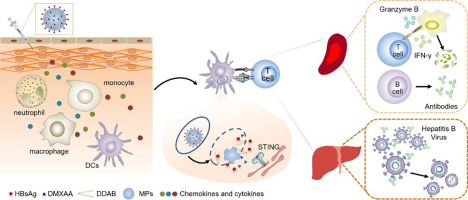当前位置:
X-MOL 学术
›
J. Control. Release
›
论文详情
Our official English website, www.x-mol.net, welcomes your feedback! (Note: you will need to create a separate account there.)
The incorporation of cationic property and immunopotentiator in poly (lactic acid) microparticles promoted the immune response against chronic hepatitis B.
Journal of Controlled Release ( IF 10.8 ) Pub Date : 2020-02-26 , DOI: 10.1016/j.jconrel.2020.02.039 Ting Lu 1 , Fumin Hu 1 , Hua Yue 2 , Tingyuan Yang 2 , Guanghui Ma 3
Journal of Controlled Release ( IF 10.8 ) Pub Date : 2020-02-26 , DOI: 10.1016/j.jconrel.2020.02.039 Ting Lu 1 , Fumin Hu 1 , Hua Yue 2 , Tingyuan Yang 2 , Guanghui Ma 3
Affiliation

|
Biodegradable microparticles (MPs) as vaccine adjuvants have sparked the passion of researchers in recent decades. However, it is still a huge challenge to develop an efficient vaccine delivery system to reverse chronic hepatitis B (CHB). Herein, we integrated a physiochemical merit and an immunopotentiator property in poly (lactic acid) (PLA) MPs and verified the therapeutic effect on CHB model mice. We prepared uniform MPs with insertion of cationic lipid didodecyldimethylammonium bromide (DDAB), which endowed a physiochemical merit for MPs. Such a DDAB-PLA (DP) group raised the recruitment of immune cells to the injection site along with the secretion of chemokines and pro-inflammatory cytokines, promoting the activation of antigen-presenting cells (APCs). Further combination of stimulator of interferon genes (STING) agonist 5,6-dimethylxanthenone-4-acetic acid (DMXAA) (DP-D) elevated 5.8-fold higher interferon regulatory factor 7 (IRF-7) expression compared to that for DP group. The DP group showed preferred lysosome escape advantage, which was in line with the DMXAA release behavior and the intracellular target of DMXAA. In addition, DP-D vaccine augmented the IFN-γ secreting splenocytes and motivated Th1-biased antibodies in a more efficient way than that for the DP group. In the CHB model, the MPs based vaccines achieved 50% HBsAg seroconversion rate, and HBcAg in the liver also got a reduction. DP-D produced higher amount of memory T/B cells to confer protection in a sustained manner. Present work thus provided a promising strategy, via integrating a fine-tuned physiochemical property and an immunopotentiator virtue in the MPs, which synergistically reinforced both humoral and cellular immune responses against CHB.
中文翻译:

聚乳酸微粒中阳离子性质和免疫增强剂的结合促进了对慢性乙型肝炎的免疫反应。
近几十年来,可生物降解的微粒(MPs)作为疫苗佐剂激发了研究人员的热情。然而,开发有效的疫苗递送系统以逆转慢性乙型肝炎(CHB)仍然是巨大的挑战。在这里,我们整合了聚乳酸(PLA)MP中的理化优点和免疫增强剂特性,并验证了其对CHB模型小鼠的治疗作用。我们制备了插入阳离子脂质十二烷基二甲基溴化铵(DDAB)的均匀MP,这赋予了MP的理化优势。这样的DDAB-PLA(DP)组与趋化因子和促炎细胞因子的分泌一起,将免疫细胞募集到注射部位,从而促进了抗原呈递细胞(APC)的激活。干扰素基因激动剂(STING)的进一步刺激组合5 与DP组相比,6-二甲基黄嘌呤-4-乙酸(DMXAA)(DP-D)将干扰素调节因子7(IRF-7)的表达提高了5.8倍。DP组表现出较好的溶酶体逃逸优势,这与DMXAA释放行为和DMXAA的细胞内靶标相符。另外,与DP组相比,DP-D疫苗以更有效的方式增加了分泌IFN-γ的脾细胞,并激发了受Th1偏向的抗体。在CHB模型中,基于MP的疫苗实现了HBsAg血清转化率50%,肝脏中的HBcAg也降低了。DP-D产生了大量的内存T / B单元,以持续提供保护。因此,目前的工作通过在MP中整合微调的理化特性和免疫增强剂,提供了一种有前途的策略,
更新日期:2020-02-26
中文翻译:

聚乳酸微粒中阳离子性质和免疫增强剂的结合促进了对慢性乙型肝炎的免疫反应。
近几十年来,可生物降解的微粒(MPs)作为疫苗佐剂激发了研究人员的热情。然而,开发有效的疫苗递送系统以逆转慢性乙型肝炎(CHB)仍然是巨大的挑战。在这里,我们整合了聚乳酸(PLA)MP中的理化优点和免疫增强剂特性,并验证了其对CHB模型小鼠的治疗作用。我们制备了插入阳离子脂质十二烷基二甲基溴化铵(DDAB)的均匀MP,这赋予了MP的理化优势。这样的DDAB-PLA(DP)组与趋化因子和促炎细胞因子的分泌一起,将免疫细胞募集到注射部位,从而促进了抗原呈递细胞(APC)的激活。干扰素基因激动剂(STING)的进一步刺激组合5 与DP组相比,6-二甲基黄嘌呤-4-乙酸(DMXAA)(DP-D)将干扰素调节因子7(IRF-7)的表达提高了5.8倍。DP组表现出较好的溶酶体逃逸优势,这与DMXAA释放行为和DMXAA的细胞内靶标相符。另外,与DP组相比,DP-D疫苗以更有效的方式增加了分泌IFN-γ的脾细胞,并激发了受Th1偏向的抗体。在CHB模型中,基于MP的疫苗实现了HBsAg血清转化率50%,肝脏中的HBcAg也降低了。DP-D产生了大量的内存T / B单元,以持续提供保护。因此,目前的工作通过在MP中整合微调的理化特性和免疫增强剂,提供了一种有前途的策略,



























 京公网安备 11010802027423号
京公网安备 11010802027423号